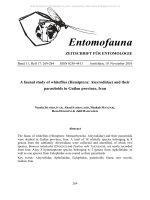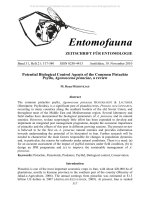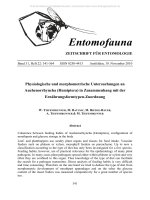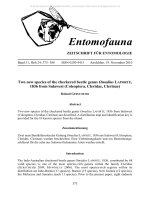Entomofauna, ZEITSCHRIFT FÜR ENTOMOLOGIE VOL 14-0221-0231
Bạn đang xem bản rút gọn của tài liệu. Xem và tải ngay bản đầy đủ của tài liệu tại đây (704.8 KB, 12 trang )
6ntomof auna
ZEITSCHRIFT FÜR ENTOMOLOGIE
Band 14, Heft 11: 221-232
ISSN 0250-4413
Ansfelden, 10. Mai 1993
New species of Cossyphodinae from Africa
(Coleoptera, Tenebrionidae)
and
Description of the Host Ant Messorferreri sp. nov.
(Hymenoptera, Formicidae)
J. Ferrer & CA. Collingwood
Abstract
A new species of Cossyphodes, C. mourgliai FERRER sp. nov. from Zambia,
together with new species of Cossyphodinus, C. bremeri FERRER sp. nov. from Kenya and
C. basilewskyi FERRER sp. nov. from Zambia, are described. Cossyphodes decimcarinatus
FERRER, 1990, is transferred to the genus Cossyphodinus. The description of Messor
ferreri COLLINGWOOD sp. nov., host ant of Cossyphodinus bremeri sp. nov., is given.
Zusammenfassung
Eine neue Art der Gattung Cossyphodes, C. mourgliai FERRER sp. nov. aus
Zambia, sowie neue Arten der Gattung Cossyphodinus, C. bremeri FERRER sp. nov. aus
Kenya und C. basilewskyi FERRER sp. nov. aus Zambia, werden beschrieben. Cossyphodes
decimcarinatus FERRER, 1990, wird in die Gattung Cossyphodinus gestellt. Messor ferreri
COLLINGWOOD sp. nov., eine Wirtsameise von Cossyphodinus bremeri sp. nov., wird
beschrieben.
221
Introduction
Prof. Dr. HJ. BREMER from Heidelberg University kindly sent me specimens of
Cossyphodinae from Mt. Elgon, Kenya, collected by him and from Zambia collected by our
colleague Dr. R. MOURGLIA, Turin. These Cossyphodinae include new taxa described in
this paper. The host ant of Cossyphodinus bremeri sp. nov. proved to be a new species of
Messor is described as an appendix to this paper.
New species and a new combination in Cossyphodinae
by J. FERRER
Cossyphodes mourgliai FERRER sp. nov.
Diagnosis: Superficially recalling the form of body of Cossyphodes
kundelunguensis BASE.EWSKY, 1950, but more strongly convex, exhibiting strongly and
highly elevated carina both ventrally and dorsally.
Length: 3.1 mm; maximum width: 1.2 mm.
Reddish, shiny, bare, exhibiting isodiametrical reticulation and apterous. Head
semicircular in a nearly regulär explanated curve from canthon to epistoma. Ocular
canthon forming an acute near right angle with the lateral clypeo-epistomal explanation.
Vertex forming a feebly curved line at a near right angle to the posterior side of the ocular
canthon. Eyes small, narrowly constricted, occupying a space approximately equal to half
the lateral portion of the canthon as measured in dorsal view. Frons deeply impressed
before and between the eyes, with two subconcentric impressions parallel to the eye. Four
smaller ünpressions are placed as follows: two anteriorly and two posteriorly in the
epistomal portion in front of the eyes (fig. 1). Two moderate elevations are placed at the
sides of the epistome corresponding to the insertion of the antennae in the inferior face of
the head. Antennae invisible in dorsal aspect and normally retracted in Special excavations
in the inferior side of the head.
Pronotum 1.3 X as broad as long, subparallel at sides with obtusely rounded
anterior angles and right angled but rounded posterior angles. The front border is strongly
sinuate through the extreme ridged elevations of the thorax. Sides broadly explanate, each
side as broad as the width of three ridges. Discal zone excavate and limited laterally by
two anteriorly convergent ridges. Posterior border sinuate as the anterior border resulting
in a wavy ridged conformation of the dorsal surface.
Elytra ovally acuminate at apex nearly 1.3 X as long as broad, with very flattened
sides continuing the lateral explanation of the pronotum. The disc is very convex with each
elytron having 5 ridges including the sutural. Intervals between the ridges broaden towards
the centre and form a peculiar elevation visible in profile from the lateral explanate sides
of the elytra as shown in fig. 3. This elevation is carinate. The epipleurae are visible in
lateral view and the dorsal carinae converge apically. Lower part of body depressed, bare,
shiny, isodiametrical, feebly punctured, showing the same flattened aspect as the dorsum.
The head shows a well developed gular explanation at the sides completely
concealing the eyes and most of the antennae; mentum excavated, concave anteriorly with
222
small basal teeth at the sides; mandibles black, shining and pointed (fig. 6).
Prostemum carinated at each side exhibiting a pointed superficially excavated
apophysis (fig. 5). Abdomen depressed showing peculiar middle and lateral carinae. The
disposition of these carinae is as follows: First abdominal stemite carinated at each side of
the middle forming a weakly excavated depression between each carina at the sides. The
space between the carinae occupies less than 1/3 of the breadth of the abdomen. Sternites
3, 4 and 5 each have another carina at each side. The space between the carinae is feebly
excavated anteriorly and truncated anteriorly at the metasternal zone becoming obsolescent
at the apex (fig. 2). The aedeagus is lanceolate, length 0.1 mm. (Fig. 4).
Habitat: This species was found under stones without indications.
Derivatio nominis: I am pleased to designate this species afler my friend and
colleague Dr. Ricardo MOURGLIA from Turin, specialist of African Cerambycidae.
Holotype: Male, Zambia, Kafue city, Kafue river, 1200 m, Lusaka, 22.XI. 2.XÜ.1987, R. MOURGLIA leg. (coll. Prof. H.J. BREMER).
Paratype: Same provenance, sexe not examined (auÜWs coll.).
Cossyphodinus bremeri FERRER sp. nov.
Dimensions: Length 3.5 mm, maximum width 2 mm.
Diagnosis: Closely related to the Cossyphodinus group of leleupi (BASILEWSKY
1950: 183), but different from all previously known species by peculiar disposition of
elytral carinae: In this new species carinae 4-5 of elytra are complete as in leleupi, but free,
not united laterally. This new species is similar to Cossyphodinus decimcarinatus (FERRER
1990) but exibits smaller eyes and 3 carinae obsolescent basally at disc (only 2 carinae are
obsolescent basally in decimcarinatus).
Body largely oval, the outline of the head, prothorax and elytra being nearly
continuous. Head large and semicircular, almost flat, vertex nearly straight, weakly curved
inwards. Front without carinae, moderately convex at middle, from vertex to front.
Epistome weakly impressed on either side with a small, oblique, longitudinal line,
occupying the supraocular portion before the eyes, corresponding to the insertion of
antennae in the inferior side of the head. Eyes very small, facetted, separated from each
other by a distance equivalent to 10 X the width of a eye, measured dorsally.
Pronotum large, transverse, trapezoidal, nearly 2 and 1/2 X broader than long,
feebly but regularly curved at sides, continuing the regulär line from epistome of head to
elytral apex, much flattened at the sides, finely and feebly keeled down on either side of its
disc, also with two complete, raised striae and an other obsolescent in the posterior 1/2
zone on either side of pronotum.
Elytra likewise keeled and much flattened laterally, with 5 finely raised carinae
on either side. The disposition of those carinae are as follows: carinae 5-4 complete,
rejoining the base of elytra, carina 3 obsolescent in the anterior 1/3 of elytra. Carinae 2-1
occupying only the posterior 1/2 of elytra.
Inferior side of body finely and shortly pubescent, each hair yellowish and a little
longer than the dorsal hairs. Prostemal apophyse shaped as a peculiar "axe", subparallel
anteriorly, dilated and curved distally, without longitudinal impressions, weakly and
pointly reflexed backwards, not surpassing the limit of procoxae (fig. 9).
223
Propleurae and epimerae of meso- and metathorax exhibiting vaste cavities to
receive the legs. The excavation of mesothorax is large and semicircular.
3 first abdominal stemites .broader as others and probably fused, first stemite
narrow.
Aedeagus: Lanceolated and asymmetric (fig. 8).
Habitat: Collected in the nest of an undescribed species of ant, agreeing to the
genus Messor and described by CA. COLLINGWOOD under the name M. ferreri in an
appendice of this paper.
Distribution: Probably endemic from Mt. Elgon.
Holotype: Male, Kenya, Mt. Elgon, 2.200 m, 23.vii.1988, leg. HJ. BREMER
(deposited in Zoologische Staatssammlung München / ZSM).
Paratypes: 9 specimens, sexe not examined, same provenance (4 specimens in
ZSM, 2 specimens in author's coll., 1 specünen in coll. Albert ALLEN, Idaho), 1 specimen
in Museum National d'Histoire Naturelle, Paris, 1 specimen in Transvaal Museum,
Pretoria.
Cossyphodinus basilemkyi FERRER sp.. nov.
Diagnosis: Similar to Cossyphodinus leleupi (BASILEWSKY, 1950) and related
species C. decimcarinatus (FERRER, 1990) and C. bremeri sp. nov. and exhibiting as
decimcarinatus lateral carinae 5, 4, 3 entirely rejoining the base of elytra, different of all
those species by carina 2 longer, practically as long as the others, but becoming a little
obsolescent at base. carina 1 shorter as in all species of the genus. As C. leleupi this new
species exhibites carinae 5-4 rejoining together laterally, but this species is longer, finely
pubescent and exhibites largely lanceolated and feebly impressed longitudinally prostemal
apophyse.
Length 4 mm, maximum width 2 mm.
Reddish, shiny, finely covered with a extremely short, yellowish pubescence
dorsally. Body oval, as the precedent species. Head semicircular, exhibiting two feebly
impressions at each side of the epistoma placed before the anterior border of the eye. Eyes
separated at front by a distance equal to about 12 X the width of a eye measured dorsally.
Pronotum transverse, about twice broader than long, exhibiting subparallel sides, obtuse
anterior angles and subright posterior angles. Base straight exhibiting a large zone at
middle, separated from the disc of pronotum by a deeply impressed horizontal carina,
enlarging this zone at middle and becoming very narrow laterally, with the posterior
angles. Two longitidinally traced carinae are placed at each side of the disc, as in C.
leleupi. The first carina is placed nearly discally and is feebly interrupted at middle, the
second, extern carina is shorter, disappearing at middle, basally.
Elytra longely oval, about 1.6 X longer as broad, exhibiting 5 carinae disposed as
following: 1 carina shorter discally, obsolescent at middle. Carinae 2, 3, 4 and 5 rejoining
the base of elytra, the 2nd and 3rd a little feebly raised, 4-5 stronger and rejoining together
apically. carina 3 feebly impressed apically. The holotype is clearly
224
asymmetric, the right 3rd carina becoming obsolescent and exhibiting only 2-3 points
apically, the left side exhibiting a well impressed third carina into the apex. Base of elytra
right.
Underside of body finely pubescent, covered with a yellowish pubescence a little
longer as dorsally. Prostemal apophyse large, lanceolated and feebly impressed
longitudinally (fig. 12).
Aedeagus lanceolated and asymmetric (fig. 11), more sinuated apically than in
the anterior species.
Holotype: Male, Zambia, Kafue city, Kafue river, 1200 m, Lusaka, 22.XI. 2.XÜ.1987, R. MOURGLIA leg., ex coll. Prof. H.J. BREMER
(deposited in Zoologische Staatssammlung München).
Cossyphodinus decimcarinatus (FERRER, 1990) comb. nov.
Describing this species from Kenya, I have erroneously placed it in the genus
Cossyphodes WESTWOOD, 1850, because the antennal club apparently was fused by 2
Segments. However, this species exhibites antennal club simple and tarsal combination: 5,
4, 4. Obviously it has to be transferred to the genus Cossyphodinus WASMANN, 1899:
Cossyphodes decimcarinatus FERRER, 1990, = Cossyphodinus decimcarinatus (FERRER,
1990) comb. nov. This species differs from all other previously described species of this
genus by three entire carinae of elytra.
Acknowledgements
I am very grateful to my friends, Dr. R. MOURGLIA, Turin; Prof. Dr. H. J.
BREMER, Heidelberg, collecting in Africa and giving me an occasion to study and describe
this very interesting material, and to Mr. C.A: COLLINGWOOD, identifying and describing
the host ant of Cossyphodinus bremeri sp. nov.
225
2 ran
Figs. 1-6 Cossyphodes mourgliai FERRER sp. nov.: 1) Habitus; 2) Abdomen; 3) Profile view
of apical portion of elytra; 4) Aedeagus; 5) Prosternal apophyse; 6) Underside of head.
226
Figs. 7-9 Cossyphodinus bremeri FERRER sp. nov.: 7) Habitus; 8) Aedeagus; 9) Prostemal
apophyse.
227
11
Figs. 10-12 Cossyphodinus basilewskyi FERRER sp. nov.: 10) Habitus; 11) Aedeagus; 12)
Prostemal apophyse.
228
Description of the host ant of Cossyphodinus bremeri FERRER sp. nov.
(Hymenoptera, Formicidae)
by C. A. Collingwood
Messor ferreri COLLINGWOOD sp. nov.
Measurements of the holotype worker in mm: Total length 11.2, head length
2.82, head width 3.10, scape length 2.10, maximum eye length 0.47. Funiculus segment 1 :
2+3 = 32 : 37.
Head of usual Messor shape with very weakly indented clypeal border, almost
Square with rounded occipital comers and medially indented occipital margin. Propodeum
obliquely angulate, unarmed. Antennal scape with subdecumbent hairs. Whole of head
finely striate to occiput with a small area above the narrowest part of frons clear of
sculpture apart from widely scattered small punctures. Whole of alitrunk reticulo-striate
with the sides of the mesonotum and the whole of the propodeum strongly striate; petiole
coarsely sculptured; postpetiole almost smooth; gaster completely smooth. Dorsum of head
with a few scattered hairs, none on occipital margin and other hairs restricted to mandible
base and clypeus which are coarsely sculptured. Propodeum with one suberect hair, dorsum
of petiole and postpetiole without hairs. First gaster tergite hairless. Colour entirely black.
Paratype workers have variable head sculpture but with fme striae extending
over at least half of dorsal surface. Eye size ranging from 0.153 - 0.19 X head width.
Propodeum obliquely angled to rounded without dorsal hairs.
This species differs from Messor angularis SANTSCHI, 1914, by the much smaller
eyes, the presence of several oblique hairs on the ventral surface of the hind femora and by
the presence of an angular prominance on the antero-ventral surface of the postpetiole. It
differs from Messor galla MAYR, 1904, by the absence of dorsal hairs on the petiole and
postpetiole, the more sculptured head and the dark colour. These are the only two species
redescribed by BOLTON (1982) in his revision of the Afrotropical Messor that in any way
resemble M. ferreri. Another species, widespread in Arabia and the Middle East, Messor
ebeninus FOREL, 1910, looks superficially similar but is of smaller size, has larger eyes and
has a few dorsal hairs on the petiole, postpetiole and first gaster tergite (COLLINGWOOD
1986).
According to the data labeis attached to the 4 specimens collected, M. ferreri was
taken under a stone together with the inquiline beetle Cossyphodinus bremeri FERRER sp.
nov. on the East face of Mt. Elgon, Kenya at 2.200 m. by HJ. BREMER, 23.vii.1988.
Holotype and 1 paratype in Zoologische Staatssammlung München, 1 paratype in
Natural History Museum Stockholm , 1 paratype in coll. of the author.
229
3.10 r-
Figs. 13-15 Messorferreri COLLINGWOOD sp. nov.: 13) Head frontal, 14) Habitus lateral; 15
Habitus dorsal.
230
References
BASILEWSKY, P. • 1950. Descnptions de deux coleopteres myrmecophiles nouveaux de Katanga. Col.
Cossyphodidae. - Rev. Bot Zool. Africaine 63(1-2): 182-187.
BOLTON, B. - 1982. Afrotropical species of the myrmicinae ant genera Cardiocondyla, Leptothorax,
Melissotarsus, Messor and Cataulacus (Fonnicidae). - Bull. Brit Mus., Ent Ser. 45(4): 307-340.
COLLINGWCiOD, CA. - 1986. Hymenoptera: Farn. Formicidae of Saudi Arabia. Fauna of Saudi Arabta,
vol.7: 230-302.
FERSER, J. - 1990. Una nueva especie de Cossyphodes (Westw.) de Kenya. (Col. Cossyphodidae). - Nouv.
Rev. d'Ent (N.S.) 7(2): 215-218.
FOREL, A. - 1910. Glanures myrmecologiques. Formis de Palestine et de Syrie, recoltees par MM. Ernest
Schmitz et Gadeau de Kerville. - Annais. Soc. Ent Belgique. 56: 6-32.
MAYR, G. - 1904. In Jägerskiöld, A. L. K. E. Results of the Swedish Zoological Expedition to Egypt and
the Withe Nile (dec. 1900-july 1901), Part 1, section 6, Formiciden, 11 pp. Uppsala.
SANTSCHI, F. - 1914. In Voyage de Ch. Alluaud et R. Jeannel en frique Orientale. - Insectes Hymenopteres,
2. Formicidae, 43, 2 pl., 30 fgs. Paris.
WASMANN, E. - 1899. Neue Termitophilen und Myrmecophilen aus Indien. - Dtsch. Ent Zeitschr. 1: 162165, pl.2.
WESTWOOD, J.O. -1850. Description of three new Genera of Exotic Coleoptera. - Trans. Soc. Ent London:
168-171.
Authors' addresses:
J. FERRER
Stora hundensgata 631
S-136 64 Haninge
Sweden
C. A . COLLINGWOOD
City Museum
Leeds
LSI 3AA England
231
Literaturbesprechung
FOREY, P.L. et al.: Cladistics. A practical course in systematics. - Oxford University Press,
Oxford, 1992. 191 S.
Systematik ist die Grundlage der gesamten Biologie, Kladistik ist eine gängige
Methode der phylogenetischen Systematik, die für die Artbildung eine dichotome Verzweigung der Stammart voraussetzt. In der Kladistik basiert die rekonstruierte Abstammung mehr auf allgemeinen Verwandtschaftsbeziehungen, als auf einfachen anatomischen
Ähnlichkeiten. Als Produkt eines von der britischen "Systematics Association"
durchgeführten Kurses über Kladistik, versucht dieses Buch eine aktuelle Übersicht der
Techniken einer modernen Kladistik zu vermitteln: "CharakterKodierung", "KladogrammTechniken", "Statistik", "DNA-Analyse", "Fossilien und kladistische Analyse",
"Kladistische Biogeographie" und "Formale Klassifikation" sind die relevanten Themen,
durch die sich der an Systematik interessierte Student "durchbeißen" muß. Für einen
deutschsprachigen Student ohne einschlägige Vorkenntnisse eine wahrlich harte Angelegenheit, denn der knapp gehaltene Text steht auf hohem Niveau.
R. GERSTMEIER
DEJOUX, C , ILTIS, A. (eds.): Lake Titicaca. A synthesis of limnological knowledge. Kluwer Academic Publishers, Dordrecht-Boston-London, 1992. 573 S.
Aufgrund seiner enormen Höhenlage (3800 m), Größe (über 8500
km2) und Tiefe (284 m) gehört der Titicacasee sicher zu den extremsten Seen dieser Erde.
Seine über hundert Jahre währende Erforschung gehört sicher zu den spannendsten Kapitel
modemer Limnologie einerseits, andererseits weist sie noch erhebliche Lücken auf, so daß
wir von einem vollständigem Verständnis dieses einzigartigen Ökosystems noch weit
entfernt sind. Beginnend mit der Geomorphologie, über Palaeohydrologie und Klimatologie, werden physikalische und chemische Parameter, Phytoplankton, Makrophyten,
Zooplankton, Benthos und die Fischfauna vorgestellt. Ethnologie, Ökonomie, das hydrologische und ichthyologische Potential sowie die Verschmutzung sind die angewandten
Aspekte dieses Buches. Sehr gute Karten, etliche Grafiken, fantastische Strichzeichnungen
vieler Organismen und 6 Farbtafeln illustrieren dieses Buch, welches als obligatorische
Informationsquelle für alle zukünftigen Titicacasee-Forscher richtungsweisende Pflichtlektüre ist. Der bisherige Forschungsstand und der zukünftige Forschungsbedarf ist diesem
empfehlenswerten Standardwerk zu entnehmen.
R. GERSTMEIER
Druck, Eigentümer, Herausgeber, Verleger und für den Inhalt verantwortlich: Maximilian Schwarz,
Konsulent für Wissenschaft der O.Ö. Landesregierung, Eibenweg 6, A - 4052 Ansfelden.
Redaktion: Erich Diller, MQnchhausenstraße 21, D - 8000 München 60.
Max Kühbandner, Marsstraße 8, D - 8011 Aschheim.
Wolfgang Schacht, ScheiTerstraße 8, D - 8081 Schöngeising.
Thomas Witt, Tengstraße 33, D - München 40.
Postadresse: Entomofauna, MünchhausenstraBe 21, D - 8000 München 60.
232









